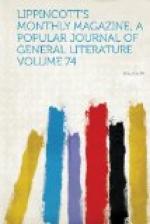“I niver hunted much myself, but I’ve heerd an old man tell—Higgins by name. Ef you could find him and could get him right, he’d tell you right smart o’ stories about varmints, and Injuns too. I’ve heerd him tell how he went out with some puppies one time to larn ’em to hunt bear. He heerd one o’ the puppies a-screechin’, and kase he didn’t want to lose him he run up. The screechin’ come from a sort o’ scrub, and he got clost up afore he see it was a she-bear and two cubs. The bear had the puppy, but when she see Higgins she dropped hit and made for him. Now, you know, a bear ain’t like no varmint nor cow-beast; hit don’t go ’round under the trees, but jest makes a road for itself over the scrub. Higgins hadn’t no time to take aim, and ef he’d ’a missed he was gone, sure ’nough; so he jest drawred his knife, and when she riz up to clutch him he stuck her plum in the heart. Killed her, dead.
“No, I never had no trouble with Injuns. They was all gone to the Nation when I settled yere, but I see Billy Bow-legs onct, and Jumper, too. I was ago-in’ through the woods, and I met a keert with three men in it. Two on ’em was kinder dark-lookin’, but I never thort much of that till the man that was drivin’ stopped and axed me ef I knowed who he had in behind. It was them two chiefs, sure ’nough: right good-lookin’ fellers they was, too.”
We had left the sandhills of the Ridge, and had reached the borders of the Scrub, but there was yet another of the new Northern settlements to visit. It lay a few miles beyond Geneva Lake, in the flat woods to the south of Santa Fe Lake, the largest and best known of the group.
Who does not know the dreary flat-woods villages of the South, with their decaying log cabins and hopelessly unfinished frame houses—with their white roads, ankle-deep in sand, wandering disconsolately among fallen trees and palmetto scrub and blackened stumps? Melrose is like them all, but with a difference. The decaying cabins, new two years ago, are deserted in favor of the great frame houses, which, unfinished indeed, have yet a determined air, as if they meant to be finished some day. The sandy roads are alive with long trains of heavy log-trucks or lighter freight-wagons; there are men actually buying things in the three stores; there is a school, with live children playing before the door; there are saw- and grist-mills buzzing noisily; there is a post-office, which connects us with the outer world as we receive our waiting letters; there is a stir of enterprise in the air which speaks quite plainly of Chicago and the Northern States, whence have come the colonists; there is talk of a railroad to the St. John’s on the east, and of a canal which shall connect the lakes with one another and with the railway on the west; there is a really good hotel, where we spend the night in unanticipated luxury upon a breezy eminence overlooking the silver sheet of Santa Fe Lake, which stretches away for miles to the north and eastward.




